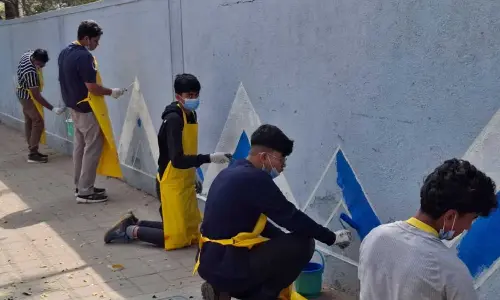Water- the foundation of the universe

Water- the foundation of the universe
The close relationship between the existence of water and the flourishing of life is well known
The close relationship between the existence of water and the flourishing of life is well known. Not only have civilisations sprouted on the banks of rivers in the history of mankind, but even the search for extraterrestrial life in the universe (Search for Extra Territorial life – or SETI), is primarily an exercise to discover whether water exists on a given celestial. Water has been described as the' foundation of the universe'.
As is known the state of Punjab acquired its name from the fact that the five rivers namely Jhelum, Chenab, Ravi, Sutlej and the Beas flow through it. According to Vedic scriptures, in fact, water is said to be of the same age as the universe, having originally been inside an egg from which the entire cosmos emanated. The resemblance of this theory (but for the water part) to the currently accepted 'standard model' theory regarding the origin of the universe, can hardly be missed.
One recollects the excitement one felt when, as a teenager, my uncle Dr. Gandhi used to take us children on a ride to Kotipalli village to watch the Godavari in flood rushing past to meet the sea which was only a short distance away.
Human beings depend on rain as the most important source of freshwater. While marine life can subsist on salt water, life on land needs fresh water for survival. And rain is the primary means for the creation of freshwater. While processes such as desalination of ocean water are, no doubt, available, they are prohibitively expensive and, therefore, impractical. Even in the verses of the Holy Quran every stage in the formation of rain is described, which is called the resource that 'gives life to a dead land' and sustains men and cattle. Like any other good thing there can be such a thing as too much of rain. An allusion is also to be found in the Holy Bible.
According to the Bible water is such an important part of life that it was created on the very first day. It is further described as an element that can not only purify and provide deliverance, but also destroy evil and enemies
The importance of water, and the role it plays in religious prescriptions and tenets of faith, can be construed from the fact that in the Hindu faith, sprinkling water over one's bare feet is regarded as the equivalent of having a bath, in terms of acquiring the eligibility to perform a ritual, or to enter a temple etc. Similarly Muslims perform 'Wudu', the practice of a person washing his face, hands, arms and feet before entering a mosque to perform 'namaz'.
That the earth has a limited supply of natural resources, and that the bludgeoning population is straining those resources to an extent that as the 'tipping point' may soon be reached, is too well-known a fact to be repeated.
The need for sustainable management of natural resources, such as land, water and air, in such a manner that the inevitability of their use for development is balanced against the need for conservation, is fast gaining recognition all round the world. So far as water is concerned alarm has been expressed especially in India, about the mindless mining away of underground aquifers (some of which, as Dr. M.S. Swaminathan calls them, are actually 'sanctuaries'). This, coupled with the inability to impound and harness the rain water being received annually has caused a situation which is not only grim but actually frightening.
And there can be situations where one is surrounded by water and can still be denied access to drinking water, reminding one of the words 'water water everywhere, not any drop to drink…', to quote... Coleridge's 'the Rime of the Ancient Mariner', deriving its origin from the Greek myth of Tantalus.
While on the subject of floods it is well known that the Krishna and the Godavari rivers are usually in spate every year, around the months of August and September. I remember one time when I was driving my parents to Amalapuram, where my grandparents stayed. The journey involved crossing four 'Anicuts' (or dams), over the Godavari River. That was necessary because the two bridges spanning the Godavari at Alamuru and Siddhantam villages had yet to come up by that time.
I recollect vividly how I negotiated the car over the first Anicut, leading to what is known as the Central Delta of East Godavari district, the entry to which was a village called Bobbarlanka. The mighty Godavari was falling rapidly through the partially opened gates and over them, on my left and, on the left, there was a seemingly endless sheet of water. The margin of the road was totally invisible, and had to be guessed approximately, remembering the width of the road. A truly scary experience which I am happy to have gone through successfully!
Practices and technologies that lead to sensible use of water have, therefore, engaged the attention of political leaders, senior civil servants and scientists for several decades now.
One method that has gained wide acceptance, and proved considerably successful, is watershed management. The technology adopts what is known as the 'ridge to the valley' approach and, while ensuring that soil and water are judiciously used for the production of crops, plantations and afforestation, also results in the conservation of those two resources.
Another technology that has caught the eye of the planners as well as the farmers for over three decades now is micro irrigation comprises of techniques such as drip irrigation and sprinkler irrigation.
While these technologies have served the purpose of water conservation and judicious use in the rural areas and primarily for agriculture and related purposes, the introduction of water harvesting structures as compulsory components of building design, especially in urban areas, has proved very effective in recent times. In fact, many urban local bodies have built this requirement into their building bylaws to ensure more effective compliance.
(The writer is former Chief Secretary, Government of Dr Mohan KandaAndhra Pradesh)














